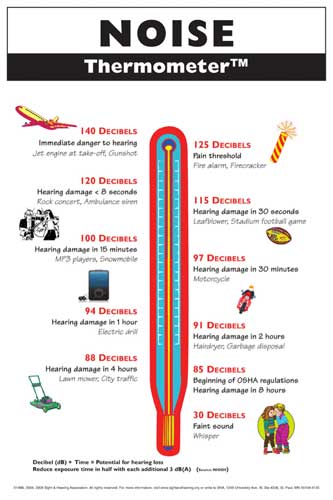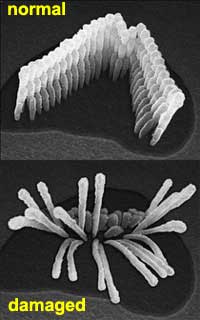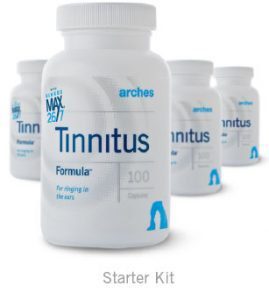By Barry Keate
Barry Keate, has lived with tinnitus over 40 years and has published 150+ research articles on numerous aspects of tinnitus. He is an expert on the condition and a well-known advocate for those with tinnitus.
Tinnitus has many causes: allergies, ear infection, Meniere’s disease, TMJ dysfunction, thyroid dysfunction, insulin resistance and various other medical conditions. The largest cause by far is hearing loss from noise exposure.

Roughly 90% of tinnitus cases accompany hearing loss. (1) Here we’ll discuss how this happens and what we can do to prevent or mitigate it.
Noise-Induced Hearing Loss
Noise-induced hearing loss (NIHL) occurs when noise damages the inner ear. This is also called sensorineural hearing loss (SNHL), because the nerves (neurons) in the inner ear are damaged, by one-time exposure to intense sound, such as an explosion, or by continual exposure to loud sounds over time.
Roughly 20% of adults in the US, or about 48 million people, report some degree of hearing loss. By age 65, 1 out of 3 people have hearing loss. (2) Many of these suffer tinnitus.
According to the American Tinnitus Association, tinnitus is the leading service-related disability among US veterans, with 9.7% of vets receiving service-related disability for tinnitus in 2012. (3) The estimated cost of rehabilitative services for tinnitus alone in 2016 was around $2.75 billion.
Some recreational activities increase the risk of NIHL. These include target shooting, hunting, snowmobiling, listening to music at high volume through earbuds or headphones, playing in a band and attending loud concerts. Lawnmowers, leaf blowers and shop or woodworking tools pose a similar risk at home and on the job.
How Hearing Works
Hearing depends on a series of events which change sound waves into finely tuned electrical signals, which the auditory nerve carries to the brain for processing and interpretation. Let’s look at each step.
1 – Sound waves from the air are collected and focused by the outer ear, then travel through the ear canal to the eardrum.
2 – Sound waves vibrate the eardrum. The eardrum transmits the vibrations to three tiny bones in the middle ear: the malleus, incus and stapes, the smallest bones in the body. They are anchored at one end to the eardrum and at the other end to the round window, which surrounds and protects the cochlea.
3 – The bones amplify the sound and transmit the vibrations to the cochlear fluid in the inner ear.
The Inner Ear
The real magic of hearing occurs in the inner ear. The cochlea transforms vibrations into intricately varied electrical signals, which it sends to the brain.
The cochlea is a small, snail-shaped organ. Inside it are about 20,000 hair cells. There are two types of these cells: outer hair cells, which amplify vibrations, and inner hair cells, which transform vibrations into electrical nerve impulses. Different groups of hair cells are activated by different frequencies of sound.
4 – Vibrations from the middle ear bones churn the cochlear fluid, which rushes past the hair cells, causing them to bend. This bending opens a sort of trap door underneath the hair cells, allowing the potassium-rich fluid in which they live to reach a sodium-filled fluid underneath. Potassium mixes with sodium, creating electricity. Calcium ions then enter the hair cells and trigger the release of the neurotransmitter glutamate. This transmits electrical signals from the hair cells across the synapse (the space between neurons) to neurons in the auditory nerve. (4)
5 – Glutamate then binds to receptors on the neurons and creates an electrical potential in the auditory nerve, which transmits information to the auditory cortex in the brain to be interpreted as sound.
The Chemical Basis of Hearing Loss
As we learned above, hair cells respond to specific frequencies. When they are overstimulated by noise at their respective frequencies, their supporting structure swells and can rupture, destroying the cells. If enough hair cells in any region of the cochlea die, the frequencies handled by cells in that region are not relayed to the brain.
Hearing Loss
As we learned above, hair cells respond to specific frequencies. When the cells are presented with an over-stimulation of their frequency their supportive structure becomes swollen and can rupture, destroying the hair cell. As these hair cells become damaged, they lay flat. If enough hair cells in this region of the cochlea die, the frequencies represented by the cells may not be relayed to the brain.
Most NIHL is caused by the damage and eventual death of these hair cells. Unlike bird and amphibian hair cells, human hair cells don’t grow back. Once dead they are gone for good.

When hair cells are damaged, they produce excess glutamate, which floods the neurons in the auditory nerve. This “glutamate storm” overexcites the neurons and causes them to stay active continuously, until they become chemically depleted and eventually die. This process is called glutamate excitotoxicity. When this occurs, the auditory nerve stops carrying signals for the affected frequencies to the auditory cortex in the brain. (5)
How Hearing Loss Causes Tinnitus
The brain craves input, and neurons require stimulation. This includes the neurons in the auditory cortex of the brain. Like hair cells in the cochlea, the auditory cortex is organized according to sound frequency, meaning every neuron is responsible for a different pitch. When hearing loss occurs, brain neurons for lost frequencies lack input.
When this happens, a given neuron may respond to electrical activity in adjacent regions, causing a ringing sound at that neuron’s specific pitch. So, even though there is no real sound at that frequency, the person hears it. That, by definition, is tinnitus.
Arches Tinnitus Formula
Arches Tinnitus Formula with Ginkgo Max 26/7 is clinically proven to reduce tinnitus sounds for the great majority of people who use it. Ginkgo Max 26/7 is our proprietary Ginkgo biloba extract, which has a higher concentration of the essential components necessary for tinnitus reduction. It is especially helpful for hearing loss-related tinnitus, where it succeeds with 75% to 80% of patients.
The amount of sound reduction depends on the individual. I have maintained a reduction of about two-thirds for over 20 years using Arches Tinnitus Formula.
This formula diminishes tinnitus in several ways. It is a strong antioxidant and helps reduce free radical activity in the cochlea. It increases blood flow, especially in the capillaries that feed the ears and brain, delivering increased amounts of glucose and oxygen, which are primary fuels for cells in the ears and elsewhere.
Perhaps most importantly, Arches Tinnitus Formula is a powerful glutamate antagonist, reducing the hyperactivity that damages the cochlea’s hair cells. See Arches Tinnitus Formula: The Science Behind the Product on our website.
As with all dietary supplements for specific conditions, you’ll need up to three months to judge the product’s full benefit for you.
Start using Arches Tinnitus Formula Starter Kit now to reduce annoying tinnitus sounds. The Starter Kit contains a full three-month supply of 4 bottles.
- Feel better and sleep better.
- Reduce stress.
- Take back your life!
Silence is a Science!
References:
1 – Hearing Health Foundation. http://hearinghealthfoundation.org/statistics
2 – Hearing Loss Association of America.
3 – American Tinnitus Association. https://www.ata.org/news/press-release/treating-and-curing-tinnitus-part-our-national-commitment-veterans
4 – National Institutes of Health. www.nidcd.nih.gov/health/hearing/pages/noise.aspx.
5 – Hakuba N, Koga K, Gyo K, et al. Exacerbation of noise induced hearing loss in mice lacking the glutamate transporter GLAST. J Neurosci. 2000 Dec 1;20(23):8750-3.

